Dayak
Dayak
Adil Ka’ Talino, Bacuramin Ka’ Saruga, Basengat Ka’ Jubata - being fair and tolerant towards others, in living our lives we must reflect from heaven and every breath of life we have comes from God almighty
The independent state of Nansarunai, established by the Ma’anyan Dayaks prior to the 12th century, flourished in southern Kalimantan. The kingdom suffered two major attacks from the Majapahit forces that caused the decline and fall of the kingdom by the year 1389; the attacks are known as Nansarunai Usak Jawa (meaning “the destruction of the Nansarunai by the Javanese”) in the oral accounts of the Ma’anyan people. These attacks contributed to the migration of the Ma’anyans to the Central and South Borneo region.
Coastal populations in Borneo are largely Muslim in belief, however, these groups (Tidung, Banjarese, Bulungan, Paser, Kutainese, Bakumpai) are generally considered to be Malayised and Islamised native of Borneo and heavily amalgamated by the Malay people, culture, and sultanate system. These groups identified themselves as Melayu or Malay subgroup due to the closer cultural identity to the Malay people,[21][22][23] compared from the Dayak umbrella classification, as the latter is traditionally associated with their pagan belief and tribal lifestyle.
The Dayak people classification is largely limited among the ethnic groups traditionally concentrated in southern and interior Sarawak and Kalimantan. Other native groups dwelling in northern Sarawak, parts of Brunei and Sabah, chiefly the Bisayah, Orang Ulu, Kadazandusun, Melanau, Rungus, and dozens of smaller groups were categorised under a separate classification apart from the Dayaks due to the difference in culture and history.
Other groups in coastal areas of Sabah and northeastern Kalimantan; namely the Illanun, Tausūg, Sama, and Bajau, although inhabiting and (in the case of the Tausug group) ruling the northern tip of Borneo for centuries, have their cultural origins from the southern Philippines. These groups though may be indigenous to coastal northeastern Borneo, are nonetheless not Dayak, but instead are grouped under the separate umbrella term of Moro, especially in the Philippines.
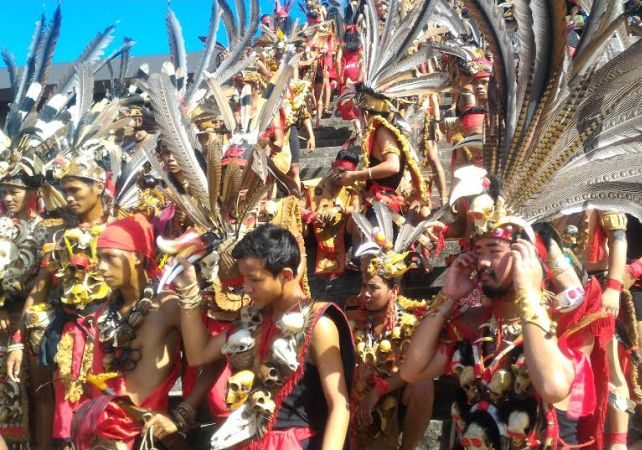 Ethnicity
Ethnicity
The term “Dayak”, a local Malay word (“daya”, “daya'” or “dayuh”) equivalent to “savages”, started out as a derogatory term used by coastal dwellers that were adopted by the British and Dutch colonial administrations as a general term referring to all non-Muslims tribes in the interior.
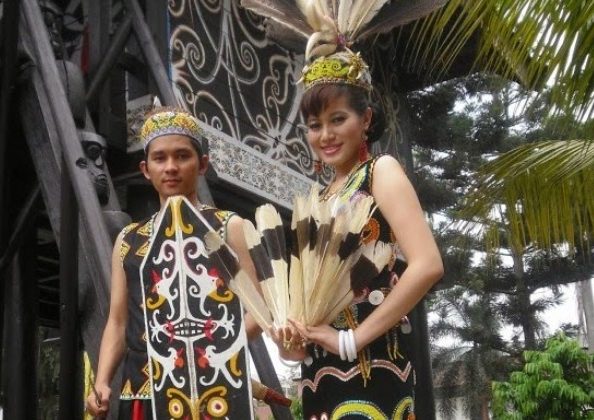 There are seven main ethnic divisions of Dayaks according to their respective native languages, customs, and cultures which are:
Ngaju;
Apo Kayan including Orang Ulu;
Iban (Sea Dayak) or Hivan;
Bidayuh (Land Dayak) or Klemantan;
Kadazan, Dusun, Murut;
Punan; and
Ot Danum.
There are seven main ethnic divisions of Dayaks according to their respective native languages, customs, and cultures which are:
Ngaju;
Apo Kayan including Orang Ulu;
Iban (Sea Dayak) or Hivan;
Bidayuh (Land Dayak) or Klemantan;
Kadazan, Dusun, Murut;
Punan; and
Ot Danum.
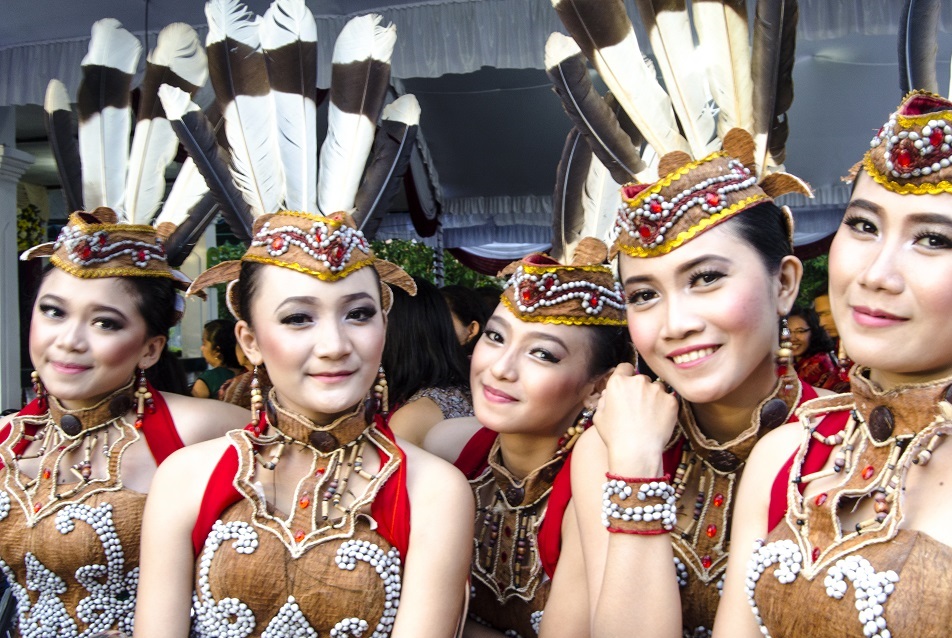 Under the main classifications, there are dozens of ethnics and hundreds of sub-ethnics dwelling in the Borneo island. There are over 30 ethnic Dayak groups speaking different languages. This cultural and linguistic diversity parallels the high biodiversity and related traditional knowledge of Borneo.
Under the main classifications, there are dozens of ethnics and hundreds of sub-ethnics dwelling in the Borneo island. There are over 30 ethnic Dayak groups speaking different languages. This cultural and linguistic diversity parallels the high biodiversity and related traditional knowledge of Borneo.
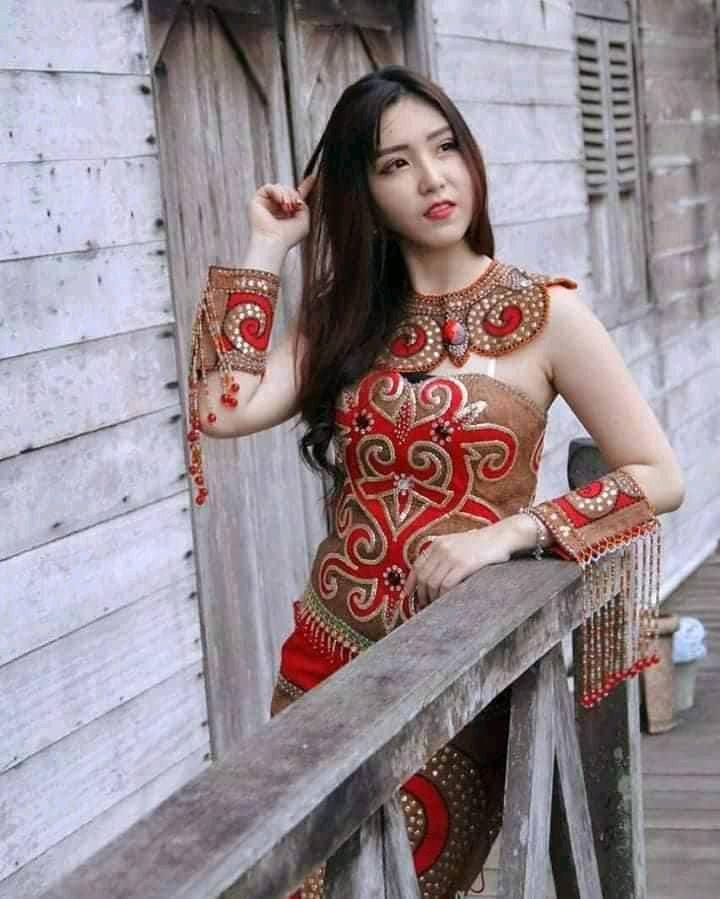 The above list of Dayak clusters by Tjilik Riwut was revised by the First International Dayak Congress and Exhibition in 2017 to become: Ngaju-Ot Danum, Apo Kayan-Kenyan, Iban, Klemantan, Kadazan-Dusun, and Punan.
The above list of Dayak clusters by Tjilik Riwut was revised by the First International Dayak Congress and Exhibition in 2017 to become: Ngaju-Ot Danum, Apo Kayan-Kenyan, Iban, Klemantan, Kadazan-Dusun, and Punan.
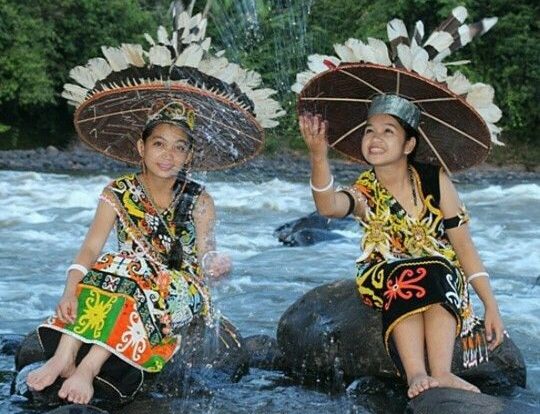 Languages
Languages
Dayaks do not speak just one language, even if just those on the island of Borneo (Kalimantan) are considered. Their indigenous languages belong in the general classification of Malayo-Polynesian languages and to diverse groups such as Land Dayak, Malayic, Sabahan, and Barito languages. Most Dayaks today are bilingual, in addition to their native language, are well-versed in Malay.
Many of Borneo’s languages are endemic (which means they are spoken nowhere else). It is estimated that around 170 languages and dialects are spoken on the island and some by just a few hundred people, thus posing a serious risk to the future of those languages and related heritage.
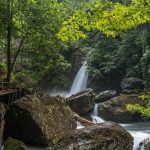
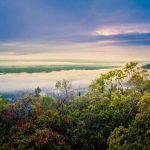
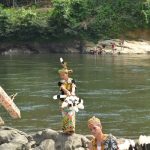
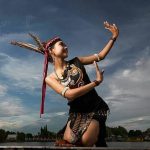
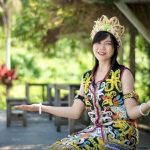
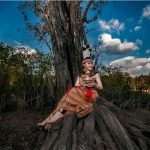
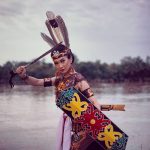
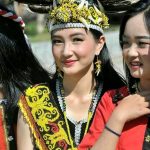

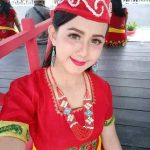
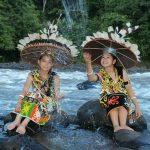

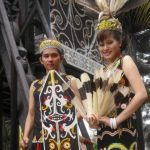



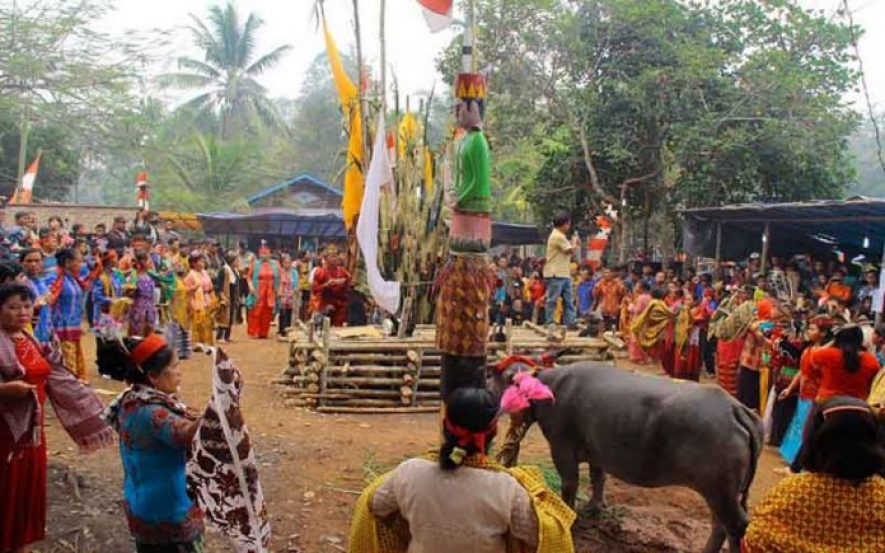 Religion
Religion
The people of the Dayak Ngaju family and the Dayak Ot Danum family adhere to the ancestral religion which is named by Tjilik Riwut as the Kaharingan religion which is characterized by the burning of bones (Ijambe) in secondary burial rituals. Meanwhile, the original religion of the Dayak Banuaka family does not recognize the burning of the corpse.
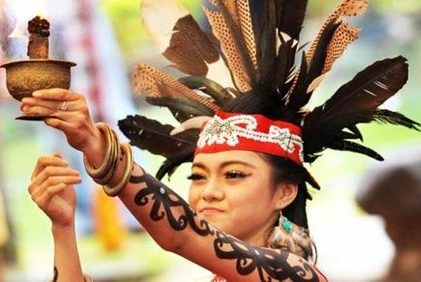 Even the ancestral religion of the Meratus Dayak people in South Kalimantan emphasizes rituals in life, especially agricultural ceremonies / rituals and harvest festivals which are often referred to as the Balian religion.
Even the ancestral religion of the Meratus Dayak people in South Kalimantan emphasizes rituals in life, especially agricultural ceremonies / rituals and harvest festivals which are often referred to as the Balian religion.
The indigenous religions of the Dayak tribes are increasingly being abandoned. Since the first century AD, Hinduism began to enter Kalimantan with the discovery of the Agung Temple, a relic of Hinduism in Amuntai, South Kalimantan, then the Hindu-Buddhist kingdoms were founded.
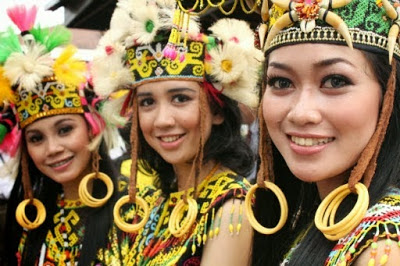 Since the 4th century, the people of Borneo have entered a historical era marked by the discovery of relics of the Hindu kingdom of Kutai in East Kalimantan.
Since the 4th century, the people of Borneo have entered a historical era marked by the discovery of relics of the Hindu kingdom of Kutai in East Kalimantan.
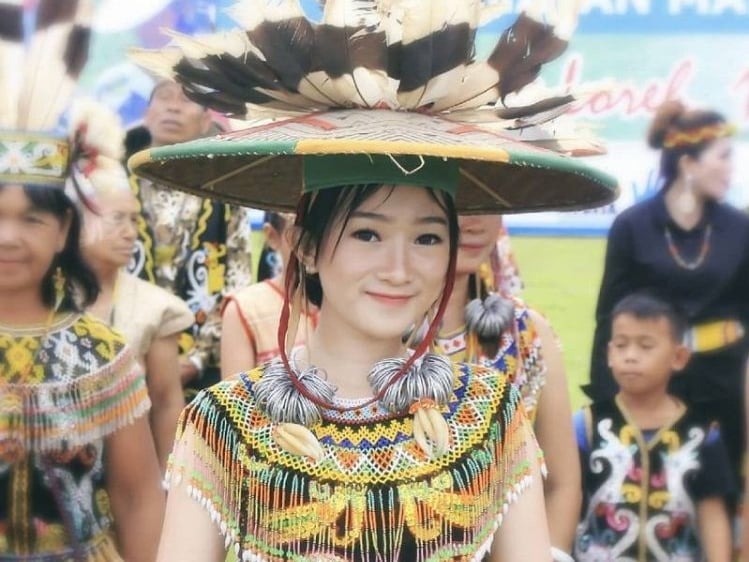 The discovery of Buddhist statues which are relics of the ancient Kingdom of Brunei, the Kingdom of Sribangun (in Kota Bangun, Kutai Kartanegara) and the Kingdom of Wijayapura. This shows the emergence of the influence of Hindu-Buddhist law and assimilation with Indian culture which marked the emergence of a multiethnic society for the first time in Kalimantan.
The discovery of Buddhist statues which are relics of the ancient Kingdom of Brunei, the Kingdom of Sribangun (in Kota Bangun, Kutai Kartanegara) and the Kingdom of Wijayapura. This shows the emergence of the influence of Hindu-Buddhist law and assimilation with Indian culture which marked the emergence of a multiethnic society for the first time in Kalimantan.
The discovery of the Sandai Tombstone shows that the spread of Islam in Kalimantan since the 7th century reached its peak in the early 16th century, the people of Hindu kingdoms became Muslims which marked the extinction of Hinduism and Buddhism in Kalimantan.
Since then, Banjar and Malay customary laws have emerged which are influenced by some Islamic religious laws (such as food culture, dress culture, purification culture), but in general the Dayak people in the interior still adhere to Kaharingan’s customary law / belief.
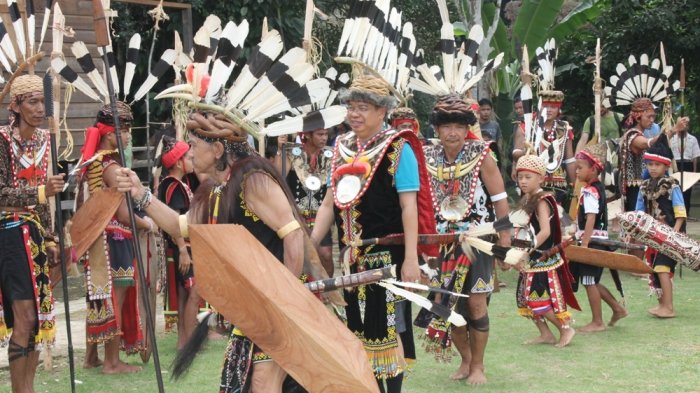 Society and customs
Society and customs
Kinship in Dayak society is traced in both lines of genealogy (tusut). Although in Dayak Iban society, men and women possess equal rights in status and property ownership, the political office has strictly been the occupation of the traditional Iban patriarch. There is a council of elders in each longhouse.
Overall, Dayak leadership in any given region is marked by titles, a Penghulu for instance would have invested authority on behalf of a network of Tuai Rumah’s and so on to a Pemancha, Pengarah to Temenggung in the ascending order while Panglima or Orang Kaya (Rekaya) are titles given by Malays to some Dayaks.
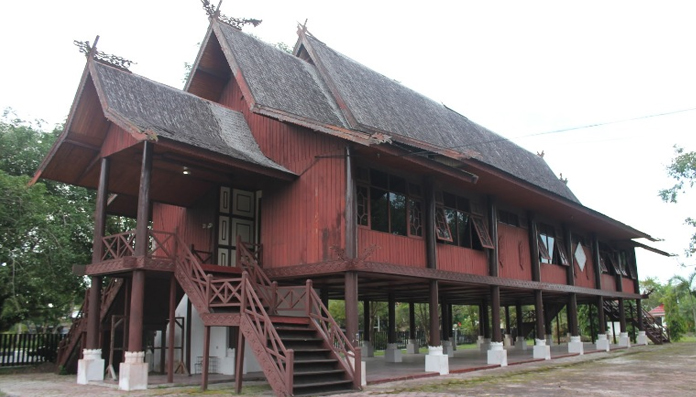 Individual Dayak groups have their social and hierarchy systems defined internally, and these differ widely from Ibans to Ngajus and Benuaqs to Kayans.
Individual Dayak groups have their social and hierarchy systems defined internally, and these differ widely from Ibans to Ngajus and Benuaqs to Kayans.
The Iban of the Kapuas and Sarawak have organised their Longhouse settlements in response to their migratory patterns. Iban longhouses vary in size, from those slightly over 100 metres in length to large settlements over 500 metres in length. Longhouses have a door and apartment for every family living in the longhouse. For example, a longhouse of 200 doors is equivalent to a settlement of 200 families.
 The tuai rumah (longhouse chief) can be aided by a tuai burong (bird leader), tuai umai (farming leader), and a manang (shaman). Nowadays, each longhouse will have a Security and Development Committee and ad hoc committee will be formed as and when necessary for example during festivals such as Gawai Dayak.
The tuai rumah (longhouse chief) can be aided by a tuai burong (bird leader), tuai umai (farming leader), and a manang (shaman). Nowadays, each longhouse will have a Security and Development Committee and ad hoc committee will be formed as and when necessary for example during festivals such as Gawai Dayak.
The Dayaks are peace-loving people who live based on customary rules or adat asal which govern each of their main activities. The adat is administered by the tuai rumah aided by the Council of Elders in the longhouse so that any dispute can be settled amicably among the dwellers themselves via berandau (discussion). If no settlement can be reached at the longhouse chief level, then the dispute will escalate to a more senior leader in the region or pengulu (district chief) level in modern times and so on.
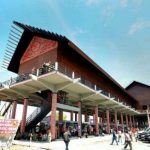
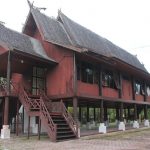
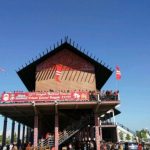
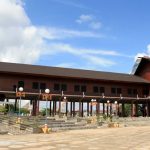
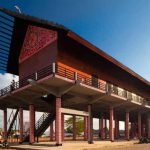

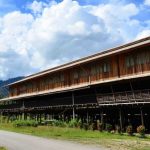
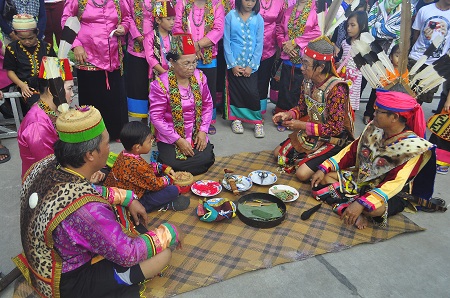 Among the main sections of customary adat of the Iban Dayaks are as follows:
Among the main sections of customary adat of the Iban Dayaks are as follows:
Adat berumah (House building rule); Adat melah pinang, butang ngau sarak (Marriage, adultery, and divorce rule); Adat beranak (Childbearing and raising rule); Adat bumai and beguna tanah (Agricultural and land use rule); Adat ngayau (Headhunting rule) and adapt ngintu anti Pala (head skull keeping); Adat ngasu, berikan, ngembuah and napang (Hunting, fishing, fruit and honey collection rule); Adat tebalu, ngetas ulit ngau beserarak bungai (Widow/widower, mourning and soul separation rule); Adat begawai (festival rule); Adat idup di rumah panjai (Order of life in the longhouse rule); Adat betenun, main lama, kajat ngau taboh (Weaving, past times, dance and music rule); Adat beburong, bemimpi ngau becenaga ati babi (Bird and animal omen, dream and pig liver rule); and also Adat belelang (Journey rule).
 The Dayak life centres on the paddy planting activity every year. The Iban Dayak has their own year-long calendar with 12 consecutive months which are one month later than the Roman calendar. The months are named in accordance with the paddy farming activities and the activities in between. Other than paddy, also planted in the farm are vegetables like ensabi, pumpkin, round brinjal, cucumber, corn, lingkau and other food sources like tapioca, sugarcane, sweet potatoes and finally after the paddy has been harvested, cotton is planted which takes about two months to complete its cycle. The cotton is used for weaving before commercial cotton is traded.
The Dayak life centres on the paddy planting activity every year. The Iban Dayak has their own year-long calendar with 12 consecutive months which are one month later than the Roman calendar. The months are named in accordance with the paddy farming activities and the activities in between. Other than paddy, also planted in the farm are vegetables like ensabi, pumpkin, round brinjal, cucumber, corn, lingkau and other food sources like tapioca, sugarcane, sweet potatoes and finally after the paddy has been harvested, cotton is planted which takes about two months to complete its cycle. The cotton is used for weaving before commercial cotton is traded.
Fresh lands cleared by each Dayak family will belong to that family and the longhouse community can also use the land with permission from the owning family. Usually, in one riverine system, a special tract of land is reserved for the use by the community itself to get natural supplies of wood, rattan, and other wild plants which are necessary for building houses, boats, coffins, and other living purposes, and also to leave living space for wild animals which is a source of meat.
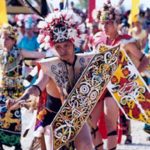

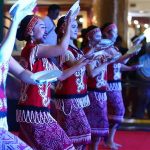

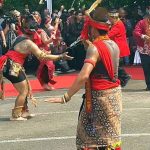
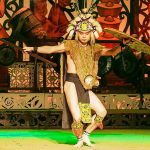
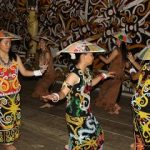
 Besides farming, Dayaks plant fruit trees like kepayang, dabai, rambutan, langsat, durian, isu, nyekak, and mangosteen near their longhouses or on their land plots to mark their ownership of the land. They also grow plants that produce dyes for colouring their cotton treads if not taken from the wild forest. Major fishing using the tuba root is normally done by the whole longhouse as the river may take some time to recover.
Besides farming, Dayaks plant fruit trees like kepayang, dabai, rambutan, langsat, durian, isu, nyekak, and mangosteen near their longhouses or on their land plots to mark their ownership of the land. They also grow plants that produce dyes for colouring their cotton treads if not taken from the wild forest. Major fishing using the tuba root is normally done by the whole longhouse as the river may take some time to recover.
Any wild meat obtained will be distributed according to a certain customary law which specifies the game catcher will the head or horn and several portions of the game while others would get an equally divided portion each. This rule allows every family a chance to supply meat which is the main source of protein.
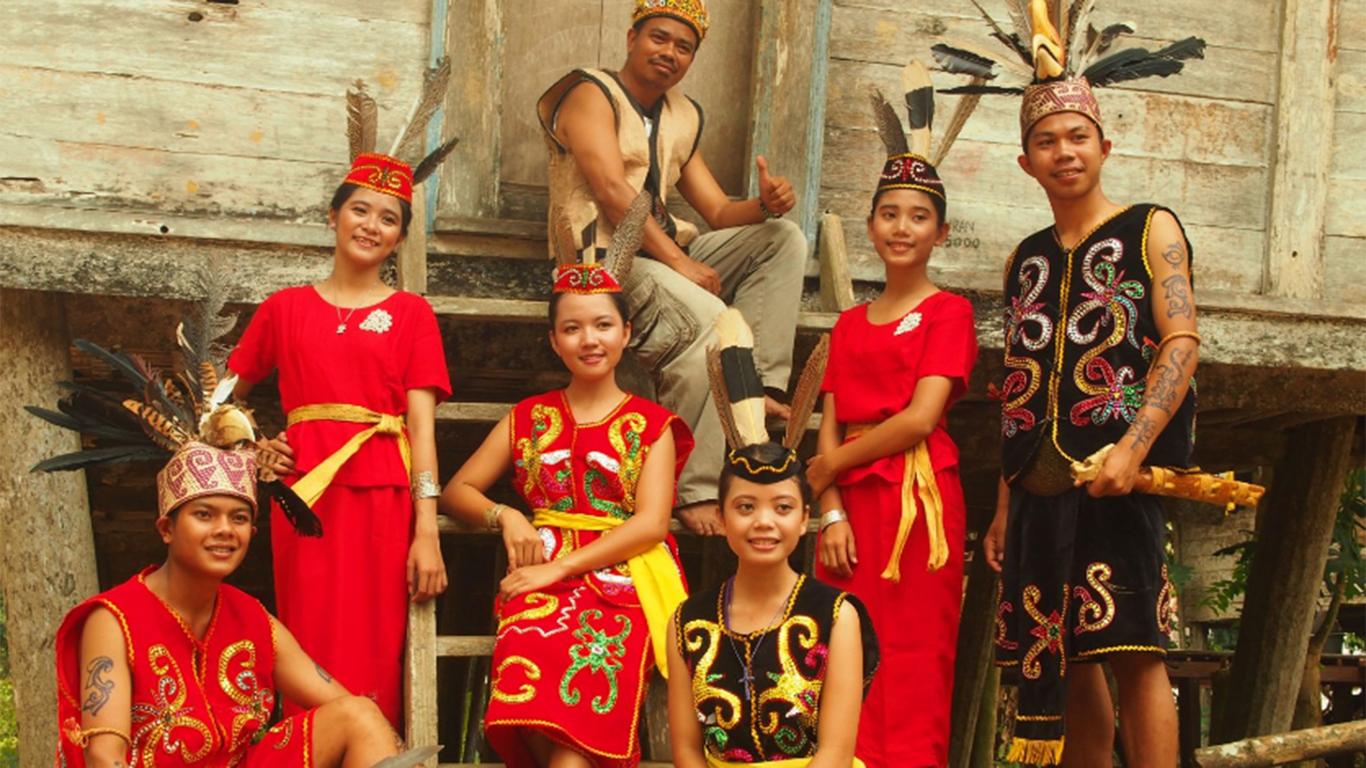 In the Indonesian region, toplessness was the norm among the Dayak people, Javanese, and the Balinese people of Indonesia before the introduction of Islam and contact with Western cultures. In Javanese and Balinese societies, women worked or rested comfortably topless. Among the Dayak, only big breasted women or married women with sagging breasts cover their breasts because they interfered with their work. Once marik empang (top cover over the shoulders) and later shirts are available, toplessness has been abandoned.
In the Indonesian region, toplessness was the norm among the Dayak people, Javanese, and the Balinese people of Indonesia before the introduction of Islam and contact with Western cultures. In Javanese and Balinese societies, women worked or rested comfortably topless. Among the Dayak, only big breasted women or married women with sagging breasts cover their breasts because they interfered with their work. Once marik empang (top cover over the shoulders) and later shirts are available, toplessness has been abandoned.
Metal-working is elaborately developed in making mandaus (machetes – parang in Malay and Indonesian). The blade is made of softer iron, to prevent breakage, with a narrow strip of a harder iron wedged into a slot in the cutting edge for sharpness in a process called ngamboh (iron-smithing).
 The ceremonial mandaus used for dances are as beautifully adorned with feathers, as are the costumes. There are various terms to describe different types of Dayak blades. The Nyabor is the traditional Iban Scimitar, Parang Ilang is common to Kayan and Kenyah Swordsmiths, pedang is a sword with a metallic handle and Duku is a multipurpose farm tool and machete of sorts.
The ceremonial mandaus used for dances are as beautifully adorned with feathers, as are the costumes. There are various terms to describe different types of Dayak blades. The Nyabor is the traditional Iban Scimitar, Parang Ilang is common to Kayan and Kenyah Swordsmiths, pedang is a sword with a metallic handle and Duku is a multipurpose farm tool and machete of sorts.
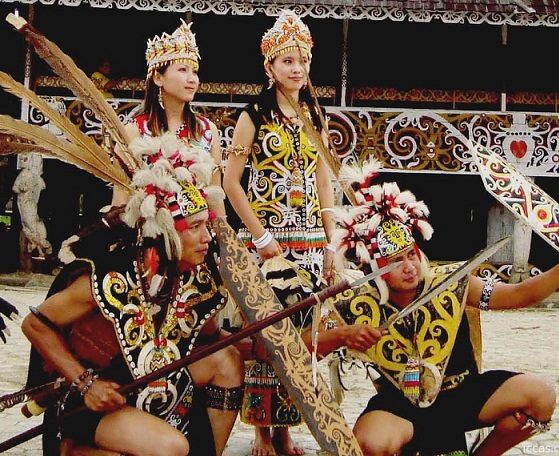 Normally, the sword is accompanied by a wooden shield called a terabai which is decorated with a demon face to scare off the enemy. Other weapons are sangkoh (spear) and sumpit (blowpipe) with lethal poison at the tip of its laja. To protect the upper body during combat, a gagong (armour) which is made of animal hard skin such as leopards is worn over the shoulders via a hole made for the head to enter.
Normally, the sword is accompanied by a wooden shield called a terabai which is decorated with a demon face to scare off the enemy. Other weapons are sangkoh (spear) and sumpit (blowpipe) with lethal poison at the tip of its laja. To protect the upper body during combat, a gagong (armour) which is made of animal hard skin such as leopards is worn over the shoulders via a hole made for the head to enter.
Dayaks normally build their long-houses on high posts on high ground where possible for protection. They also may build kuta (fencing) and kubau (fort) where necessary to defend against enemy attacks. Dayaks also possess some brass and cast iron weaponry such as brass cannon (bedil) and iron cast cannon meriam. Furthermore, Dayaks are experienced in setting up animal traps (peti) which can be used for attacking the enemy as well. The agility and stamina of Dayaks in jungles give them advantages.
Most importantly, Dayaks will seek divine helps to grant them protection in the forms of good dreams or curses by spirits, charms such as pengaroh (normally poisonous), empelias (weapon straying away) and engkerabun (hidden from normal human eyes), animal omens, bird omens, good divination in the pig liver or by purposely seeking supernatural powers via nampok or betapa or menuntut ilmu (learning knowledge) especially kebal (weapon-proof).


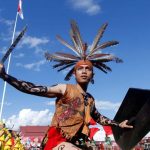
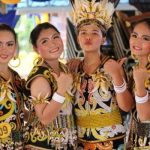
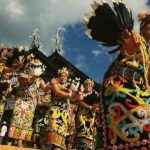

 During headhunting days, those going to farms will be protected by warriors themselves, and big agriculture is also carried out via labour exchange called bedurok (which means a large number of people working together) until completion of the agricultural activity. Kalingai or pantang (tattoo) is made unto bodies to protect from dangers and other signifying purposes such as travelling to certain places.
During headhunting days, those going to farms will be protected by warriors themselves, and big agriculture is also carried out via labour exchange called bedurok (which means a large number of people working together) until completion of the agricultural activity. Kalingai or pantang (tattoo) is made unto bodies to protect from dangers and other signifying purposes such as travelling to certain places.
The traditional Iban Dayak male attire consists of a sirat (loincloth) attached with a small mat for sitting), lelanjang (headgear with colourful bird feathers) or a turban (a long piece of cloth wrapped around the head), marik (chain) around the neck, engkerimok (ring on thigh) and simpai (ring on the upper arms).
 The Iban Dayak female traditional attire comprises a short “kain tenun betating” (a woven cloth attached with coins and bells at the bottom end), a rattan or brass ring corset, selampai (long scarf) or marik empang (beaded top cover), sugu tinggi (high comb made of silver), simpai (bracelets on upper arms), tumpa (bracelets on lower arms) and buah pauh (fruits on hand).
The Iban Dayak female traditional attire comprises a short “kain tenun betating” (a woven cloth attached with coins and bells at the bottom end), a rattan or brass ring corset, selampai (long scarf) or marik empang (beaded top cover), sugu tinggi (high comb made of silver), simpai (bracelets on upper arms), tumpa (bracelets on lower arms) and buah pauh (fruits on hand).
The Dayaks especially the Ibans appreciate and treasure very much the value of pua kumbu (woven or tied cloth) made by women while ceramic jars which they call tajau obtained by men. Pua kumbu has various motives for which some are considered sacred. Tajau has various types with respective monetary values. The jar is a sign of good fortune and wealth. It can also be used to pay fines if some adat is broken in lieu of money which is hard to have in the old days. Beside the jar being used to contain rice or water, it is also used in ritual ceremonies or festivals and given as baya (provision) to the dead.
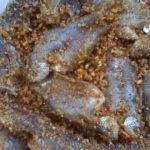
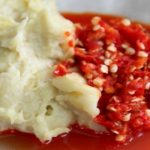
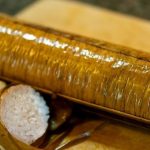
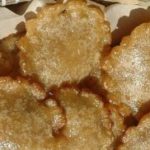
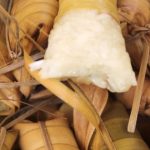
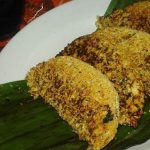
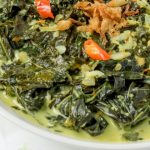
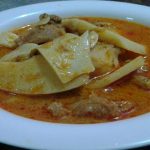
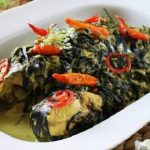
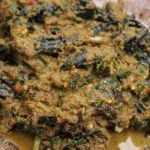
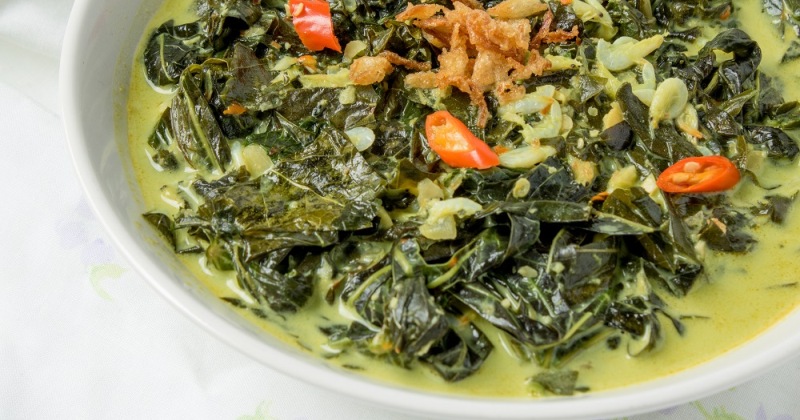 Cuisine
Cuisine
Pulled to their cultural roots, the Dayak people have various cultures regarding their eating habits. In a year the Dayak people hold a party (gawai) at least once by serving various types of food. In addition, in Dayak culture, there is no such thing as refusing guests who come to the house.
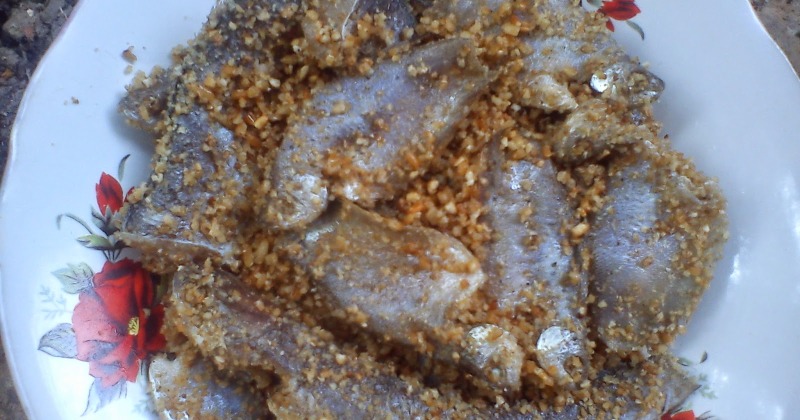 Not to mention, the stigma of a good hostess is that she provides treats to her guests. “So if there is a hostess who refuses her guests or does not give a treat, she will get gossip from the public. This is considered a disgrace, “. This is the reason why many households are accustomed to always providing more food.
Not to mention, the stigma of a good hostess is that she provides treats to her guests. “So if there is a hostess who refuses her guests or does not give a treat, she will get gossip from the public. This is considered a disgrace, “. This is the reason why many households are accustomed to always providing more food.
The concern of not having enough food to serve has made the generation of Dayak parents accustomed to cooking in a larger quantity than the actual number of residents in the house. What then happens in every household kitchen is the habit of cooking in large portions.
 This culture, rooted in the longhouse system, assumes that food should always be in the kitchen. The culture of eating is indeed strong in the generation of Dayak parents. However, these instilled values cannot suddenly change as easily as turning a palm.
This culture, rooted in the longhouse system, assumes that food should always be in the kitchen. The culture of eating is indeed strong in the generation of Dayak parents. However, these instilled values cannot suddenly change as easily as turning a palm.
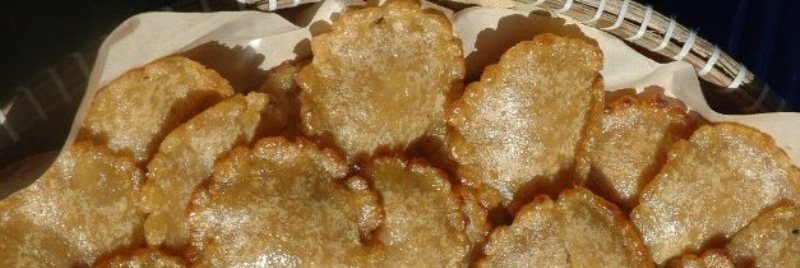 Although now it is starting to shift with more and more young people who are more concerned with how they consume food. Although their concern is more influenced by health factors. About the importance of eating healthy foods.
Although now it is starting to shift with more and more young people who are more concerned with how they consume food. Although their concern is more influenced by health factors. About the importance of eating healthy foods.
